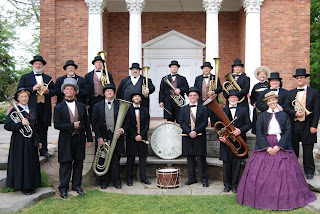Ophicleide
The early brass instrument known as the serpent was a recent focus on the Historic Brass blog. It would later evolve into the ophicleide (which roughly translates to "keyed serpent"). True to its etymology, the ophicleide is a bass instrument similar to the serpent but now instead of holes in the instrument, there are keys. The ophicleide was patented in 1821 by Jean Hilaire Asté (sometimes he is known as Halary or Haleri) who was an instrument maker in France.
In my research, the name Tony George keeps reappearing as one of the foremost authorities on this instrument. Here he demonstrates an ophicleide. Search for ophicleide on YouTube and you will be rewarded with over four-thousand videos.
There were several distinct advantages which the ophicleide provided over the serpent. Ophicleides are made of metal and therefore louder than serpents. Second, the key system was easier to use than the holes because the keys were more ergonomically placed. Also, the keyed system (which was already taking place on keyed bugles) allowed for the tone holes to be placed in more accurate locations for pitch. The ophicleide was used in Mendelssohn's Elias and Overture to a Midsummer Night's Dream and Berlioz's Symphonie Fantastique. For a time, it was the expected bass voice until the more conical tuba with its piston valves (or rotor valves) began to evolve.
If you are in the market for a brand new ophicleide you are in luck! Wessex (and I am sure others) makes brand new ones. Period instruments are used frequently by discerning professionals and, as you can imagine, substituting a tuba for an ophicleide would not result in the tone quality originally sought/expected by a Mendelssohn or a Berlioz.
The nineteenth century was a very exciting time for instrument makers: for the woodwinds as well as the brass. Entire new families of instruments were invented and sprung up into common usage and provided new sonic capabilities. While some of these instrument families are rarely played today, they still serve as a milepost on the journey of music technology.
For more information about ophicleides visit www.contrabass.com or Wikipedia
 |
| Ophicleide |
In my research, the name Tony George keeps reappearing as one of the foremost authorities on this instrument. Here he demonstrates an ophicleide. Search for ophicleide on YouTube and you will be rewarded with over four-thousand videos.
There were several distinct advantages which the ophicleide provided over the serpent. Ophicleides are made of metal and therefore louder than serpents. Second, the key system was easier to use than the holes because the keys were more ergonomically placed. Also, the keyed system (which was already taking place on keyed bugles) allowed for the tone holes to be placed in more accurate locations for pitch. The ophicleide was used in Mendelssohn's Elias and Overture to a Midsummer Night's Dream and Berlioz's Symphonie Fantastique. For a time, it was the expected bass voice until the more conical tuba with its piston valves (or rotor valves) began to evolve.
 |
| Ophicleide |
If you are in the market for a brand new ophicleide you are in luck! Wessex (and I am sure others) makes brand new ones. Period instruments are used frequently by discerning professionals and, as you can imagine, substituting a tuba for an ophicleide would not result in the tone quality originally sought/expected by a Mendelssohn or a Berlioz.
 |
Ophicleides come in a variety of sizes (like saxhorns, serpents, etc.)
|
For more information about ophicleides visit www.contrabass.com or Wikipedia



Comments
Post a Comment